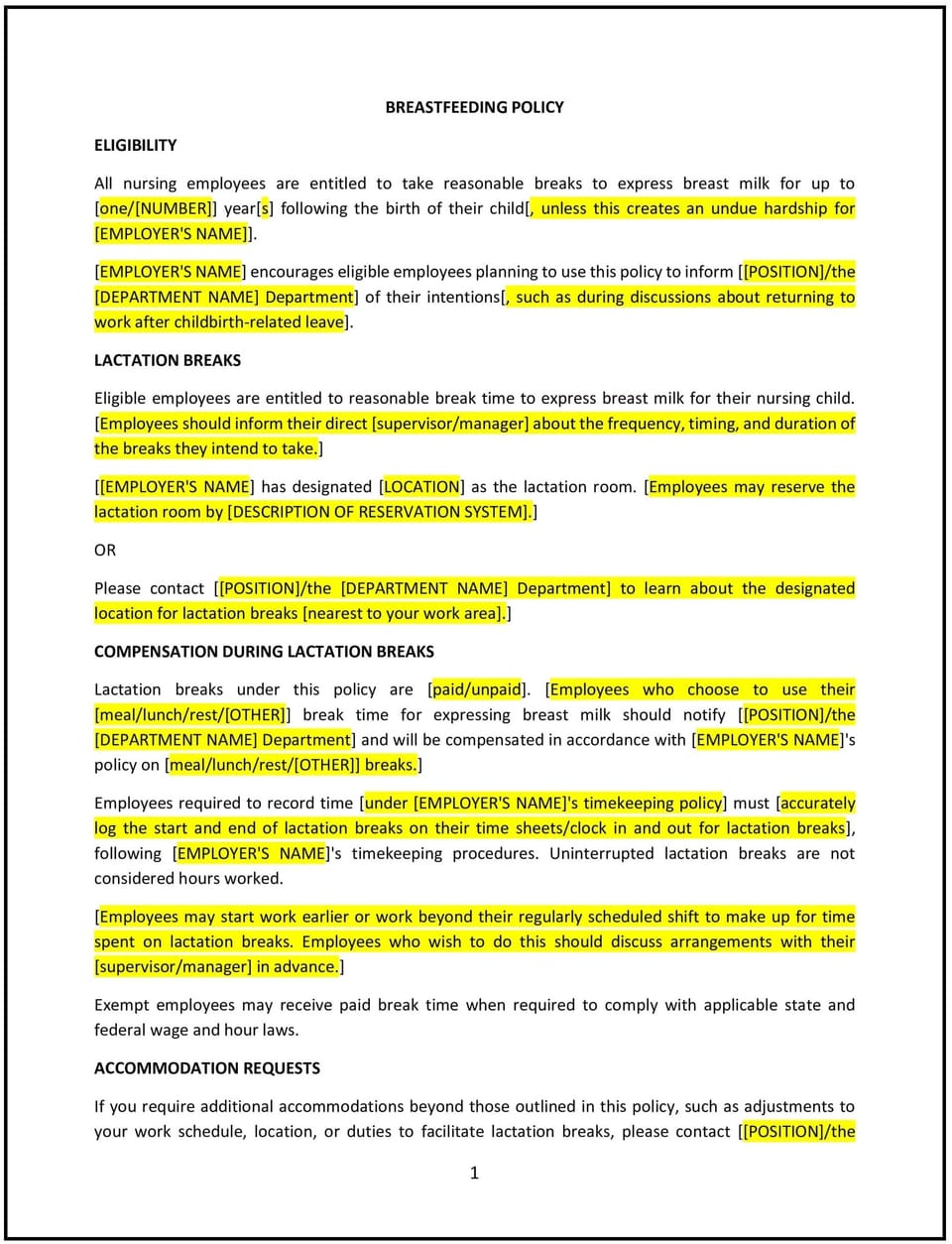Breastfeeding break policy (Hawai'i): Free template

Breastfeeding break policy (Hawaiʻi)
A breastfeeding break policy helps Hawaiʻi businesses support nursing employees by providing reasonable break time and a private space to express breast milk. This policy aligns with Hawaiʻi state laws and federal regulations, such as the Fair Labor Standards Act (FLSA), which require employers to accommodate breastfeeding employees. It is designed to promote a supportive workplace environment, enhance employee well-being, and demonstrate a commitment to work-life balance.
By implementing this policy, businesses in Hawaiʻi can foster inclusivity, improve employee retention, and comply with legal requirements.
How to use this breastfeeding break policy (Hawaiʻi)
- Provide reasonable break time: Specify that nursing employees are entitled to reasonable break times to express breast milk, typically for up to one year after childbirth.
- Offer a private space: Ensure employees have access to a clean, private space (not a bathroom) with a locking door, electrical outlets, and seating. The space should be free from intrusion and distractions.
- Communicate the policy: Share the policy with employees during onboarding and through internal communications to ensure awareness and understanding.
- Train managers: Educate supervisors on the policy’s guidelines and the importance of supporting breastfeeding employees.
- Maintain flexibility: Allow employees to schedule breaks as needed, depending on their individual needs and work responsibilities.
- Ensure compliance: Adhere to Hawaiʻi state laws and federal regulations, such as the FLSA, which require employers to provide breastfeeding accommodations.
- Review and update the policy: Regularly assess the policy’s effectiveness and make adjustments as needed to reflect changes in laws, workplace dynamics, or employee needs.
Benefits of using this breastfeeding break policy (Hawaiʻi)
This policy offers several advantages for Hawaiʻi businesses:
- Supports employee well-being: Providing breastfeeding accommodations helps nursing employees balance work and personal responsibilities, improving their overall well-being.
- Enhances retention: A supportive policy can increase employee satisfaction and loyalty, reducing turnover and associated costs.
- Promotes inclusivity: Demonstrating a commitment to supporting breastfeeding employees fosters a diverse and inclusive workplace culture.
- Improves productivity: Employees who feel supported are more likely to remain engaged and productive at work.
- Aligns with legal requirements: The policy helps businesses comply with Hawaiʻi state laws and federal regulations, such as the FLSA.
- Builds a positive reputation: A breastfeeding-friendly workplace can enhance the business’s reputation among employees, customers, and the community.
Tips for using this breastfeeding break policy (Hawaiʻi)
- Communicate the policy effectively: Share the policy with employees during onboarding and through regular reminders, such as emails or posters in common areas.
- Provide a comfortable space: Ensure the designated breastfeeding area is clean, private, and equipped with necessary amenities, such as a chair, table, and electrical outlets.
- Train managers: Educate supervisors on the policy’s guidelines and the importance of supporting breastfeeding employees.
- Be flexible: Allow employees to schedule breaks as needed, depending on their individual needs and work responsibilities.
- Respect privacy: Ensure the breastfeeding space is free from intrusion and that employees feel comfortable using it.
- Review the policy periodically: Update the policy as needed to reflect changes in laws, workplace dynamics, or employee needs.
Q: Why should Hawaiʻi businesses adopt a breastfeeding break policy?
A: Businesses should adopt this policy to support nursing employees, comply with legal requirements, and foster a positive workplace culture.
Q: What accommodations are required for breastfeeding employees?
A: Businesses should provide reasonable break time and a private, clean space (not a bathroom) for employees to express breast milk.
Q: How long should businesses provide breastfeeding breaks?
A: Businesses should provide breaks for up to one year after childbirth, as required by federal law, and consider extending support based on employee needs.
Q: What should the breastfeeding space include?
A: The space should include a locking door, seating, a table, and electrical outlets. It should be clean, private, and free from intrusion.
Q: How should businesses handle scheduling for breastfeeding breaks?
A: Businesses should allow employees to schedule breaks as needed, depending on their individual needs and work responsibilities.
Q: Are breastfeeding breaks paid or unpaid?
A: Under federal law, breastfeeding breaks are unpaid unless the employee uses existing paid break time. Businesses should clarify this in the policy.
Q: How often should the policy be reviewed?
A: The policy should be reviewed annually or as needed to reflect changes in laws, workplace dynamics, or employee needs.
This article contains general legal information and does not contain legal advice. Cobrief is not a law firm or a substitute for an attorney or law firm. The law is complex and changes often. For legal advice, please ask a lawyer.


